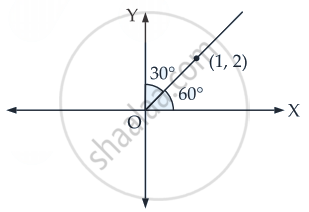Advertisements
Advertisements
Question
Find the equation of lines passing through (1, 2) and making angle 30° with y-axis.
Solution
Given that the line makes angle 30° with y-axis
∴ Angle made by the line with x-axis is 60°
∴ Slope of the line
m = tan 60°
⇒ m = `sqrt(3)`

So, the equation of the line passing through the point (1, 2)
And slope `sqrt(3)` is y – y1 = m(x – x1)
⇒ y – 2 = `sqrt(3)(x - 1)`
⇒ y – 2 = `sqrt(3)(x - 1)`
⇒ `y - sqrt(3)x + sqrt(3) - 2` = 0
Hence, the required equation of line is `y - sqrt(3)x + sqrt(3) - 2` = 0
APPEARS IN
RELATED QUESTIONS
Find the equation of the line parallel to x-axis and having intercept − 2 on y-axis.
Find the equations of the straight lines which pass through (4, 3) and are respectively parallel and perpendicular to the x-axis.
Find the equation of the straight line passing through (3, −2) and making an angle of 60° with the positive direction of y-axis.
Find the equation of the straight line which divides the join of the points (2, 3) and (−5, 8) in the ratio 3 : 4 and is also perpendicular to it.
Find the equations to the altitudes of the triangle whose angular points are A (2, −2), B (1, 1) and C (−1, 0).
Find the equation of the straight lines passing through the following pair of point :
(a, b) and (a + c sin α, b + c cos α)
Find the equation of the straight lines passing through the following pair of point :
(at1, a/t1) and (at2, a/t2)
In what ratio is the line joining the points (2, 3) and (4, −5) divided by the line passing through the points (6, 8) and (−3, −2).
Find the equation to the straight line cutting off intercepts − 5 and 6 from the axes.
A straight line passes through the point (α, β) and this point bisects the portion of the line intercepted between the axes. Show that the equation of the straight line is \[\frac{x}{2 \alpha} + \frac{y}{2 \beta} = 1\].
Find the equation of a line which passes through the point (22, −6) and is such that the intercept of x-axis exceeds the intercept of y-axis by 5.
Find the equation of the line passing through the intersection of the lines 2x + y = 5 and x + 3y + 8 = 0 and parallel to the line 3x + 4y = 7.
Find the equation of a line passing through the point (2, 3) and parallel to the line 3x − 4y + 5 = 0.
The line 2x + 3y = 12 meets the x-axis at A and y-axis at B. The line through (5, 5) perpendicular to AB meets the x-axis and the line AB at C and E respectively. If O is the origin of coordinates, find the area of figure OCEB.
Find the length of the perpendicular from the origin to the straight line joining the two points whose coordinates are (a cos α, a sin α) and (a cos β, a sin β).
Find the length of the perpendicular from the point (4, −7) to the line joining the origin and the point of intersection of the lines 2x − 3y + 14 = 0 and 5x + 4y − 7 = 0.
Find the equations of the straight lines passing through (2, −1) and making an angle of 45° with the line 6x + 5y − 8 = 0.
The equation of one side of an equilateral triangle is x − y = 0 and one vertex is \[(2 + \sqrt{3}, 5)\]. Prove that a second side is \[y + (2 - \sqrt{3}) x = 6\] and find the equation of the third side.
The equation of the base of an equilateral triangle is x + y = 2 and its vertex is (2, −1). Find the length and equations of its sides.
If the diagonals of the quadrilateral formed by the lines l1x + m1y + n1 = 0, l2x + m2y + n2 = 0, l1x + m1y + n1' = 0 and l2x + m2y + n2' = 0 are perpendicular, then write the value of l12 − l22 + m12 − m22.
Write the integral values of m for which the x-coordinate of the point of intersection of the lines y = mx + 1 and 3x + 4y = 9 is an integer.
Write the equation of the line passing through the point (1, −2) and cutting off equal intercepts from the axes.
The equation of the straight line which passes through the point (−4, 3) such that the portion of the line between the axes is divided internally by the point in the ratio 5 : 3 is
A line passes through the point (2, 2) and is perpendicular to the line 3x + y = 3. Its y-intercept is
The inclination of the straight line passing through the point (−3, 6) and the mid-point of the line joining the point (4, −5) and (−2, 9) is
Find the equation of the line passing through the point of intersection of 2x + y = 5 and x + 3y + 8 = 0 and parallel to the line 3x + 4y = 7.
If a, b, c are in A.P., then the straight lines ax + by + c = 0 will always pass through ______.
Equation of the line passing through the point (a cos3θ, a sin3θ) and perpendicular to the line x sec θ + y cosec θ = a is x cos θ – y sin θ = a sin 2θ.
